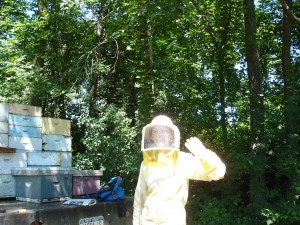
Green Living at Home, The Plight of the Bees, and Local Gardening What is it Good For? TONS!.
Students broke up into focus areas depending on their interest and passion for the subject:
Here is our schedule and our problem statements for our action project week:
Wednesday 29th: Green Living at Home
Did you know that 80% of the energy used for a machine washed load goes to heating the water, and that there is no benefit to using hot water unless it is an all-white load?
It is difficult to imagine how much energy we use , how much one flush really means, or what happens when we turn on a light connected to a coal plant. As such we would like to educate ourselves, our school, and our community about some simple things we can all do to reduce our carbon footprint.
Meet at 9am. Head over to Resource 2000 to volunteer in exchange for fence materials for our garden, and possibly model materials for a “green village.”
We will return to school between 12 and 1. Have lunch.
At 1:30 Ryland Gardner from the Boulder Green Builders Guild will speak with us about green living and building.
Thursday 30th: The Plight of the Bees
Bee populations are rapidly declining throughout the U.S. There are many theories as to why this is happening, (genetically modified crops, rough transportation, use of pesticides herbicides) humans seem to be to blame in many of these scenarios. Roughly one third of our current food supply is pollinated by bees from commercial bee farms. Food like almonds, raspberries, and many others rely on bees. Bees are a keystone species and essential to a thriving ecosystem. We want to educate ourselves and others about the importance of bees and the reason for their disappearance. One of the ways to help bees is to create habitat for them, we will finish our week by creating a bee garden!
9:00 am meet.
Christina Allen — Bee Keeper and environmental educator from Thorne Ecological Institute will meet with us in the morning to teach us all about bees.
The second part of this day we are going to create a mural all about bees and what’s happening to them, or what we think is happening to them. We will also start work on our garden which includes a special bee section!
Friday May 1st: Local gardening: what is it good for? TONS!
A healthy economy, people, and our environment all benefit from a healthy local food system. Currently, the majority of energy used in the US food system (about 80%) goes to processing, packaging, transporting, storing, and preparing food. Produce in the US travels, on average, between 1300-2000 miles from farm to customer. The fact is that we are polluting our planet through our food choices. Truck transportation has largely replace the more energy efficient methods of transporting food by train and boat. This is just part of why it is important to support locally grown agriculture. The food is also fresher, less processed, and overall healthier for humans and the environment. We will create a garden at school to help raise awareness about the benefits of local food and also to help teach others how to start gardens of their own!
Introduction to gardening, why we are doing this, reading packets and activities…
Growing Gardens is coming to help us start our garden at school. This will be the focus all day.
Others will make informational signs for the garden as well as identification signs for plants.

Leave a Reply